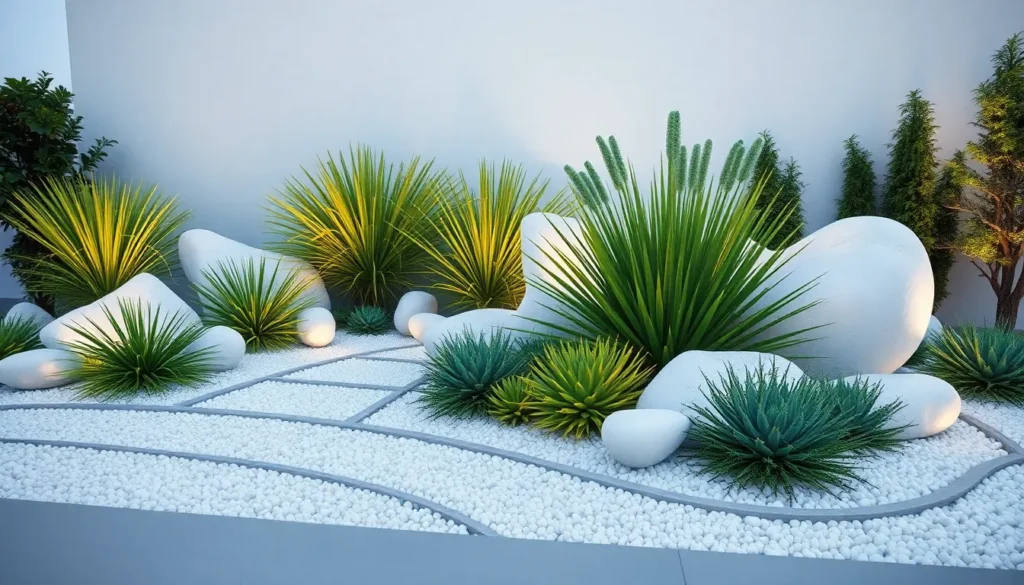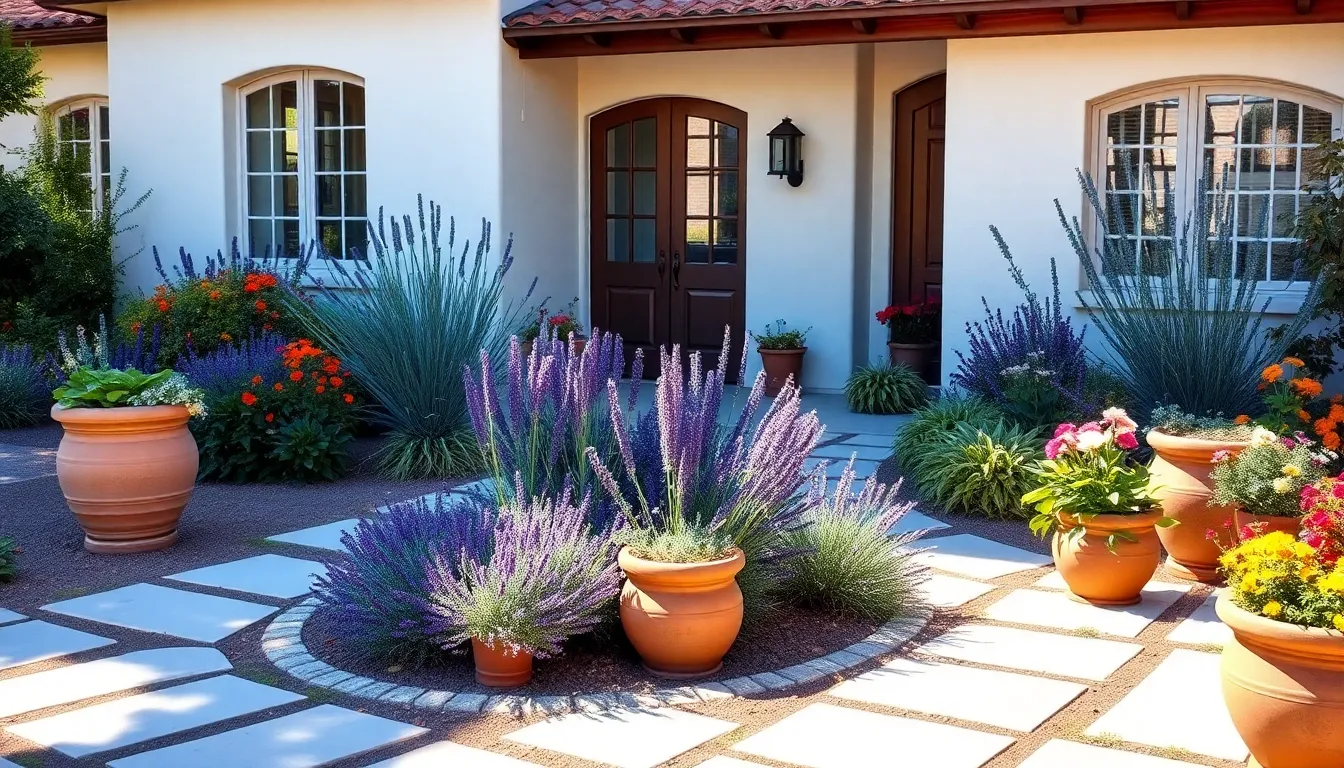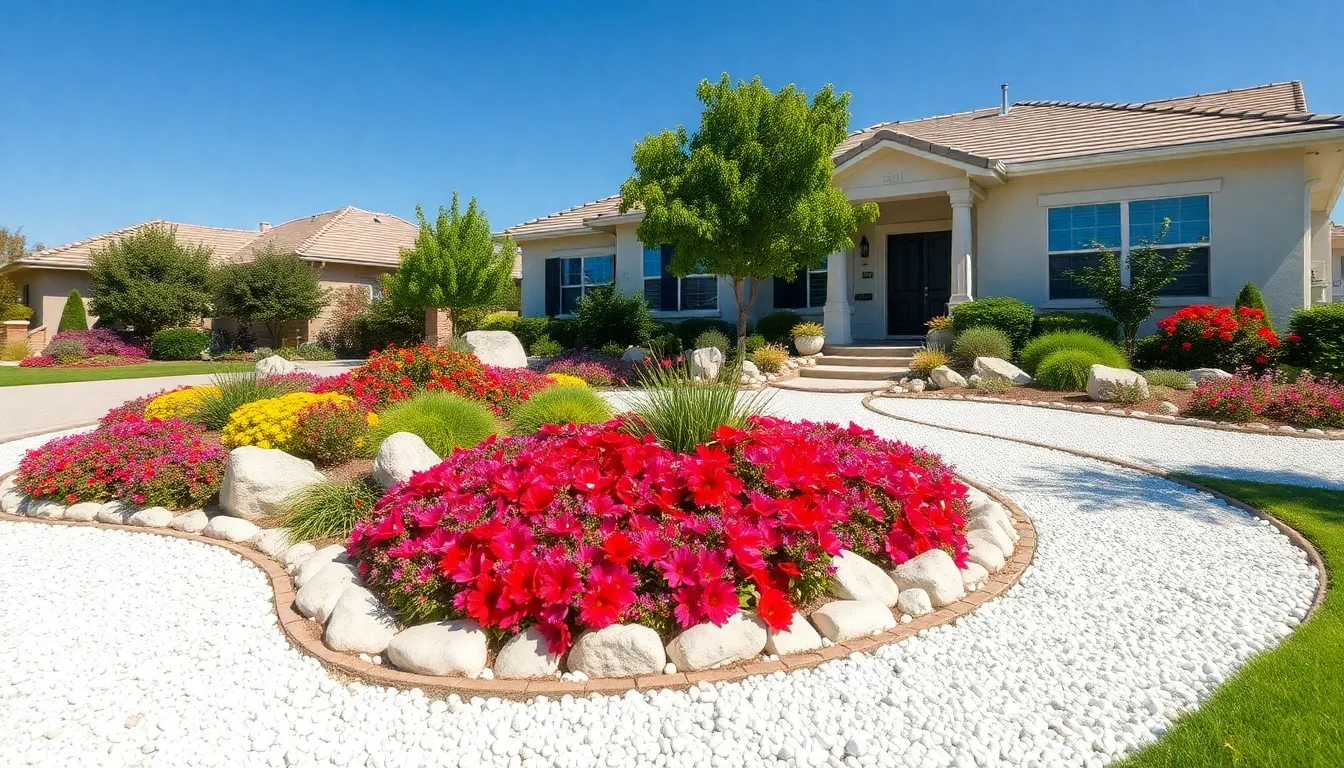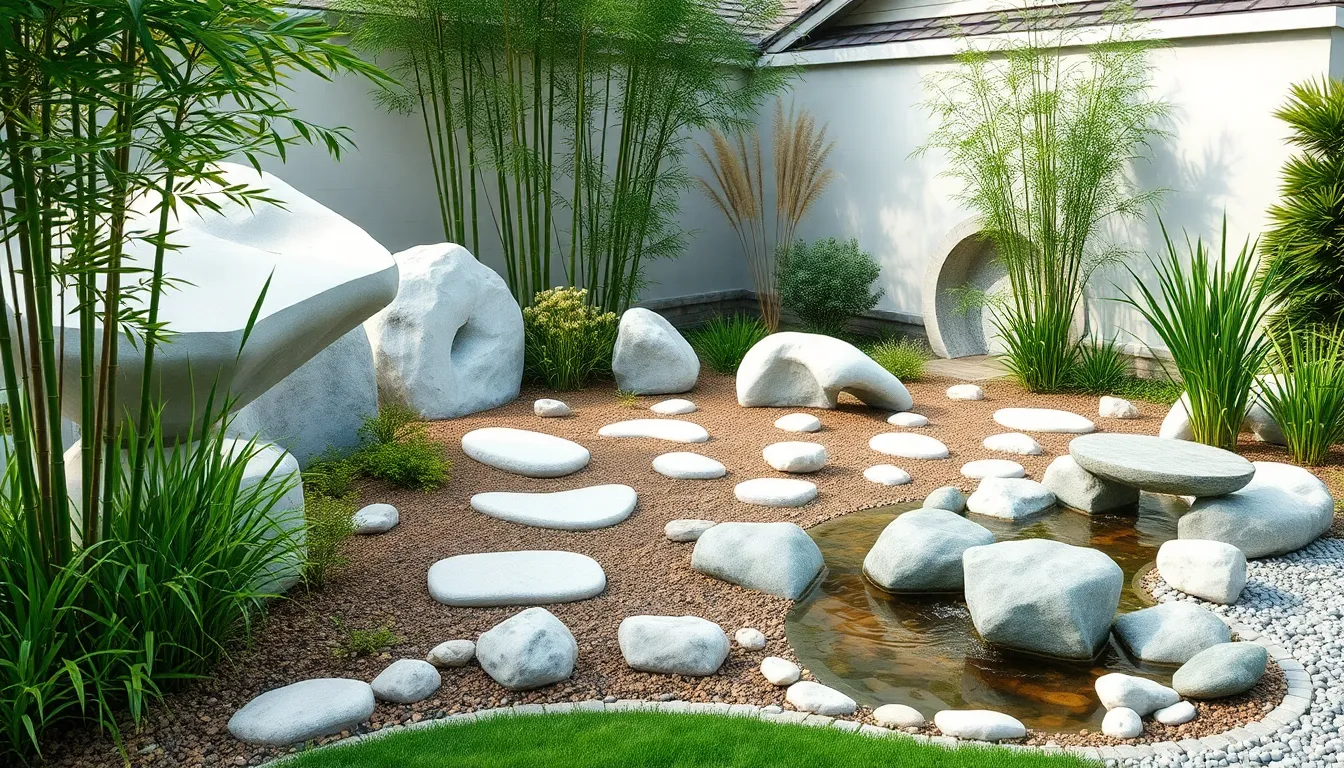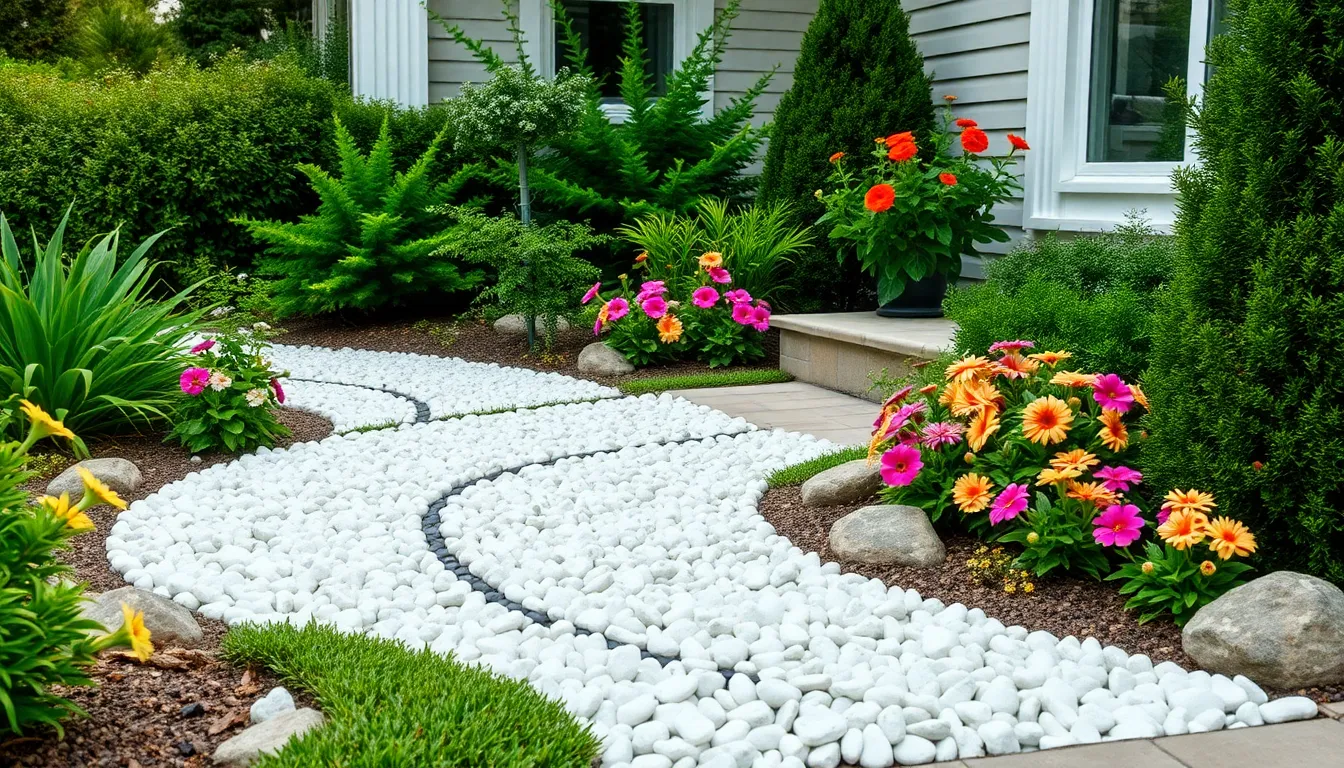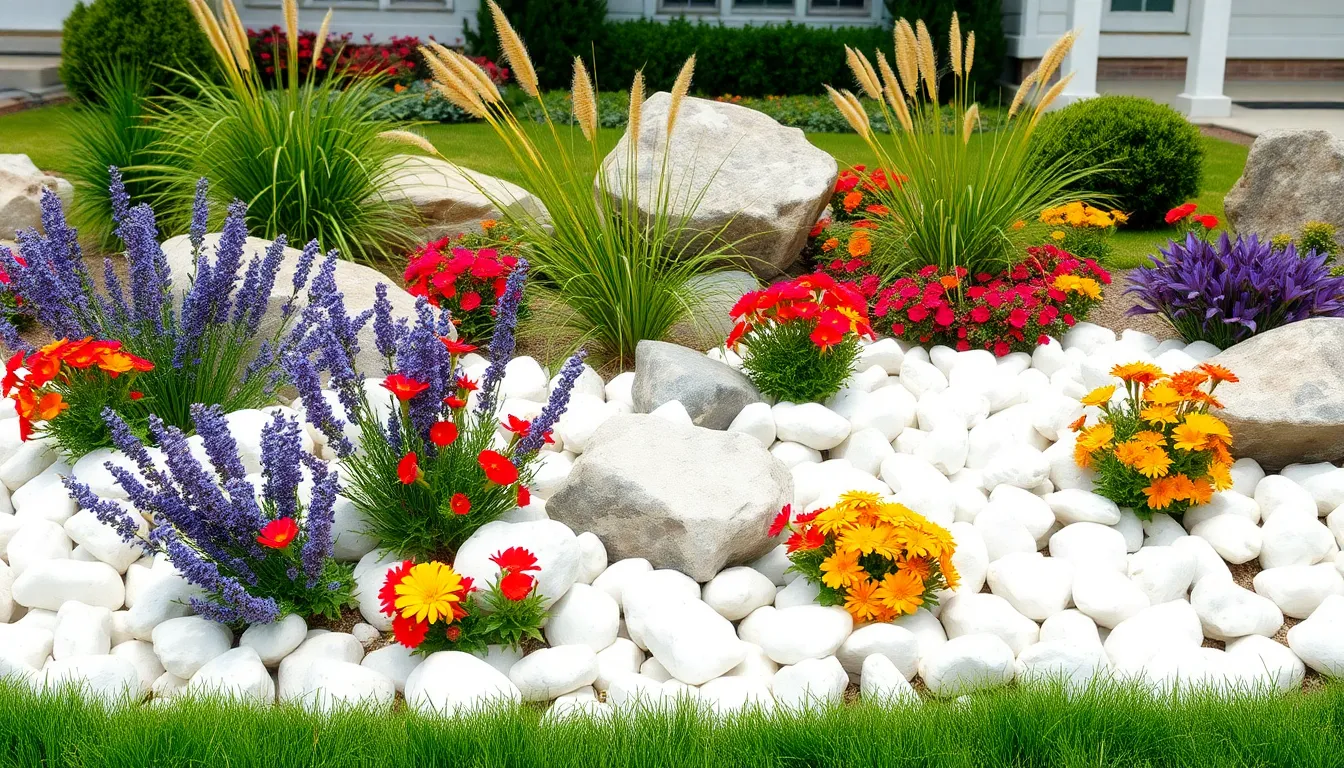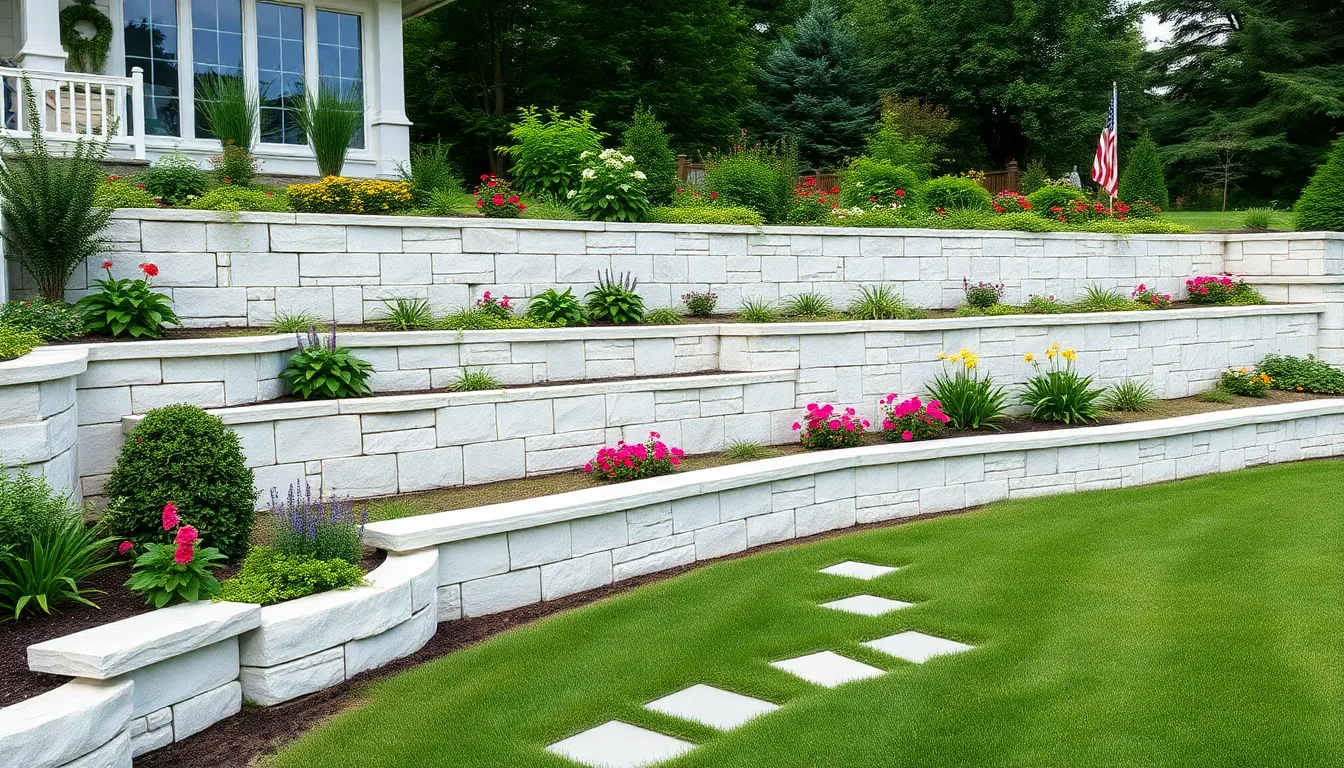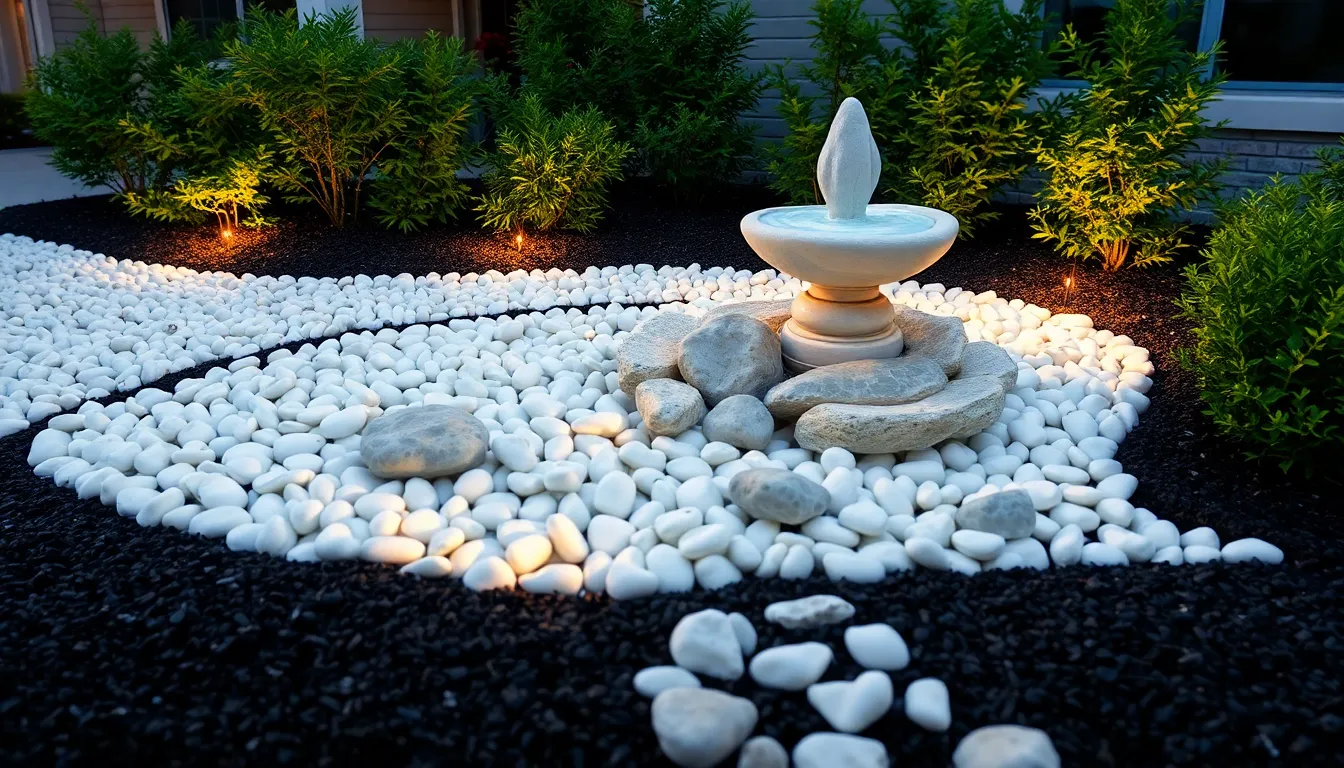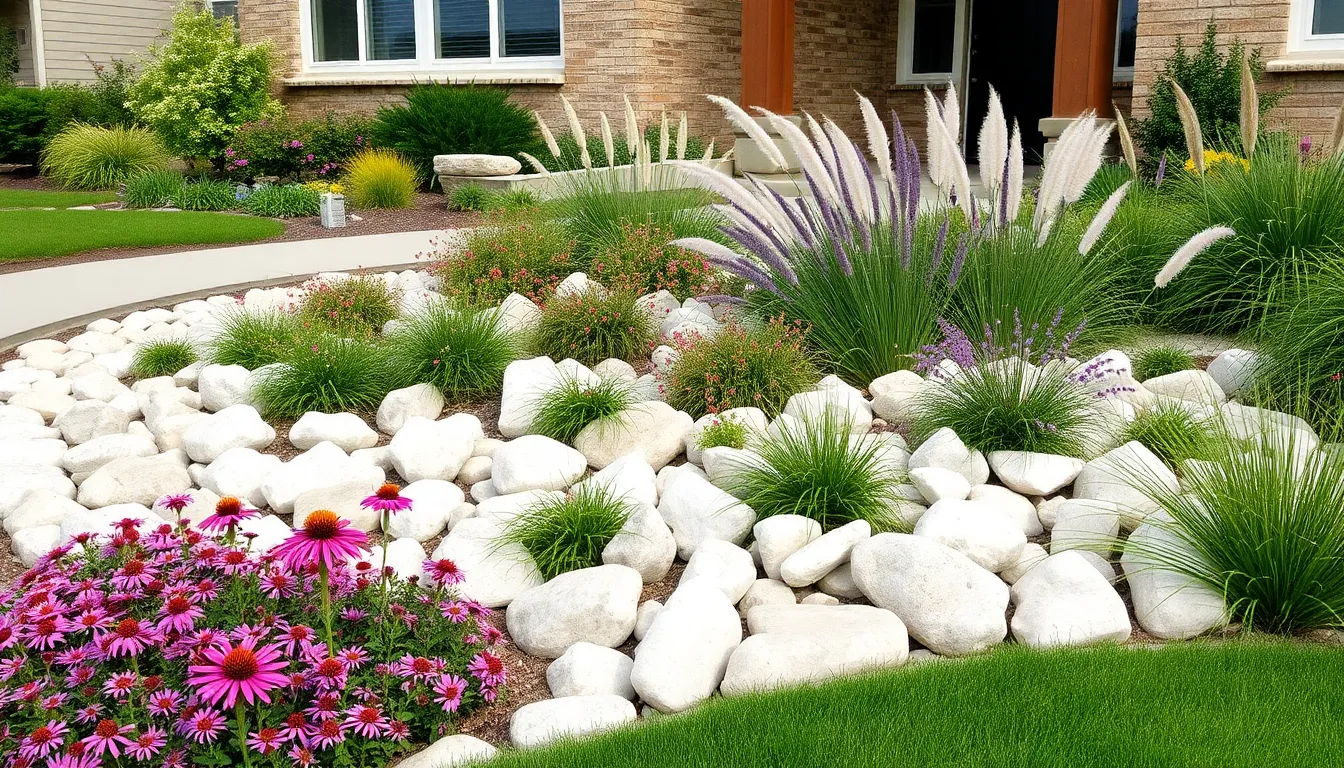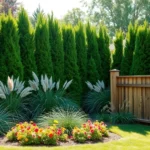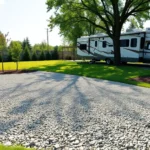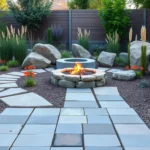Transform your front yard into a stunning showcase with the timeless elegance of white rocks. We’ve discovered that white stone landscaping creates an instant visual impact that’s both modern and classic – perfect for homeowners who want their property to stand out from the neighborhood crowd.
White rocks aren’t just beautiful; they’re incredibly practical too. We love how they require minimal maintenance while providing excellent drainage and weed suppression. From pristine white gravel pathways to dramatic boulder arrangements these versatile stones work with virtually any architectural style and plant palette.
Whether you’re dreaming of a sleek contemporary design or a charming cottage garden aesthetic white rocks offer endless possibilities. We’ll show you proven techniques that industry professionals use to create magazine-worthy front yards that boost curb appeal and property value without breaking your budget.
Create a Modern Minimalist Front Yard with White Gravel Pathways
White gravel pathways serve as the foundation for achieving a sophisticated minimalist aesthetic that transforms your front yard into a contemporary showcase. We’ll explore strategic design elements that maximize visual impact while maintaining the clean simplicity that defines modern landscaping.
Design Clean Geometric Lines
Straight-edged borders create the backbone of minimalist white rock landscaping by establishing clear boundaries between different zones. Install metal or concrete edging strips to contain white gravel within precise rectangular or square sections that complement your home’s architecture. These crisp lines prevent gravel migration while emphasizing the intentional geometry that makes minimalist designs so compelling.
Angular pathway configurations replace curved walkways to reinforce the modern aesthetic throughout your front yard space. Design main pathways using 90-degree turns and parallel lines that lead visitors directly to your entrance without unnecessary decorative flourishes. Width consistency maintains visual harmony when you keep all pathways between 3 to 4 feet wide for optimal proportions.
Rectangular planting beds positioned at strategic intervals break up expanses of white gravel without compromising the geometric theme. Create these beds using the same edging materials as your pathways to ensure design continuity across your entire front yard layout.
Incorporate Contemporary Plant Selections
Architectural succulents like agave and yucca provide dramatic focal points that thrive in white gravel environments while requiring minimal water. Position these statement plants as solo specimens within rectangular beds to create visual anchors that draw attention without overwhelming the minimalist composition. Their structural forms complement geometric hardscaping elements naturally.
Ornamental grasses such as fountain grass and feather reed grass add vertical interest through their upright growth habits and seasonal movement. Plant these grasses in linear arrangements or small clusters to maintain the clean aesthetic while introducing organic textures that soften harsh edges. Choose varieties that reach 2 to 3 feet in height for proper scale relationships.
Evergreen shrubs including boxwood and Japanese holly provide year-round structure that maintains visual interest during winter months. Trim these plants into geometric shapes like spheres or cubes to reinforce your minimalist theme while creating living architectural elements that complement white gravel surfaces.
Add Strategic Lighting Elements
LED pathway lights embedded directly into white gravel surfaces illuminate walkways while maintaining the clean lines essential to minimalist design. Install low-voltage fixtures every 6 to 8 feet along pathway edges to provide adequate visibility without creating visual clutter. These lights enhance safety while showcasing your white rock landscaping during evening hours.
Uplighting fixtures positioned at the base of specimen plants create dramatic shadows that add depth to your minimalist front yard after dark. Focus these lights on architectural succulents or trimmed evergreen shrubs to highlight their geometric forms against surrounding white gravel areas. Solar-powered options reduce installation complexity while providing eco-friendly illumination.
Linear strip lighting along pathway borders or planting bed edges emphasizes geometric boundaries through subtle illumination. These fixtures integrate seamlessly into metal edging systems to maintain clean aesthetics while providing functional lighting that guides visitors safely to your entrance.
Design a Mediterranean-Inspired White Stone Garden
White limestone creates the perfect foundation for transforming your front yard into a sun-drenched Mediterranean oasis. This timeless approach balances natural beauty with practical functionality while maintaining the sophisticated aesthetic you’ve established.
Use White Limestone for Authentic Appeal
White limestone delivers authentic Mediterranean charm with its soft, warm white tones and natural texture that mimics coastal garden settings. This durable stone creates a serene, sun-baked foundation that establishes the perfect backdrop for your Mediterranean industry design. We recommend using limestone for pathways, borders, and ground cover areas where its natural durability shines through years of weather exposure.
The stone’s subtle variations in color and texture add visual interest without overwhelming your garden’s clean aesthetic. Limestone’s porous nature allows for excellent drainage, making it ideal for Mediterranean plants that prefer well-draining soil conditions. Professional landscapers often choose this material because it maintains its appearance longer than other white stones and develops an attractive patina over time.
Plant Drought-Resistant Mediterranean Herbs
Drought-tolerant Mediterranean herbs like lavender, rosemary, thyme, and sage thrive alongside white limestone while creating stunning visual contrasts. These hardy plants conserve water naturally and add layers of fragrance, texture, and greenery that complement the stone’s neutral palette perfectly. We suggest grouping these herbs in clusters to create aromatic focal points throughout your limestone industry.
Lavender provides purple blooms that pop against white stone backgrounds, while rosemary offers year-round green structure with delicate blue flowers. Thyme creates excellent ground cover between limestone stepping stones, and sage adds silvery foliage that echoes the stone’s pale tones. These plants require minimal maintenance once established and support the sustainable gardening principles that define Mediterranean design.
Install Terra Cotta Accent Pieces
Terra cotta planters and decorative elements introduce warm reddish-brown hues that create striking visual contrast against white limestone surfaces. These rustic accent pieces add tactile interest and can be strategically positioned among stones and herbs to establish compelling focal points. We recommend selecting various sizes of terra cotta containers to create visual rhythm and prevent monotony in your garden design.
Large terra cotta urns work beautifully as statement pieces near entryways or garden corners, while smaller pots can be clustered together for intimate seating areas. The weathered finish of terra cotta develops character over time, improving the authentic Mediterranean atmosphere you’re creating. Consider planting seasonal flowers or additional herbs in these containers to add color flexibility throughout the year.
Build Striking White Rock Borders and Edging
Creating distinctive borders and edging with white rocks transforms your front yard into a professionally designed industry feature. These versatile materials establish clear boundaries while adding sophisticated visual appeal to your outdoor space.
Define Garden Beds with White River Rocks
White river rocks create bright, reflective bases that make your garden beds appear larger and more vibrant. We recommend using these stones to fill spaces between plants because they retain soil moisture while reducing weed growth significantly. Your colorful flowers and green foliage will pop against the clean white backdrop, creating stunning visual contrast that enhances curb appeal.
Larger white stones work perfectly for focal edging around flower beds, while smaller stones fill interior spaces neatly. This layered approach provides clear visual separation between different industry elements. Combining white rocks with succulents or drought-resistant plants creates an elegant, minimalist aesthetic that requires minimal maintenance throughout the seasons.
Shaded front yard areas benefit tremendously from white rocks because they reflect light effectively. This brightening effect visually enlarges darker spaces and brings a fresh, crisp feel to garden beds. Your investment in white river rocks pays dividends through reduced watering needs and fewer weeding sessions.
Create Natural Curves and Flowing Lines
Curved rock borders add softness and movement to your front yard design, creating inviting pathways that guide visitors naturally. We suggest following your yard’s natural contours with white gravel or stones to establish flowing lines that feel organic rather than rigid. This approach works beautifully with both modern and traditional garden styles.
Rock pathways made with white materials create serene, harmonious effects that mimic natural landscapes. Your eye will naturally follow these curved borders as they wind through different garden areas. Flowing lines produce a sense of movement that makes your front yard feel larger and more ever-changing.
Strategic placement of white rocks along natural curves helps establish visual rhythm throughout your industry. Different sized stones can emphasize exact areas while maintaining the overall flowing design. This technique transforms ordinary front yards into sophisticated outdoor spaces that feel professionally designed.
Maintain Proper Drainage Considerations
Proper drainage planning ensures your white rock landscaping remains beautiful and functional for years to come. We always recommend installing industry fabric under white rocks to prevent weed growth while allowing water to percolate through effectively. This foundation layer protects against soil erosion and keeps rocks from shifting during heavy rains.
Water pooling can damage both your rocks and surrounding plants, so proper grading becomes essential. Your white rock borders should direct excess water away from foundations and garden beds naturally. Strategic placement helps prevent soil compaction while maintaining the structural integrity of your industry design.
Drainage considerations also include choosing appropriate rock sizes for your exact climate conditions. Smaller white gravel allows faster water penetration, while larger stones provide better stability in areas with heavy water flow. Planning these details upfront prevents costly repairs and maintains your industry’s pristine appearance throughout all weather conditions.
Construct a Japanese Zen Garden with White Stones
Creating a Japanese Zen garden with white stones transforms your front yard into a serene meditation space that emphasizes simplicity and natural beauty. White pebbles or crushed white rocks serve as the foundation, reflecting light and adding brightness while symbolizing purity and tranquility.
Arrange Rocks in Traditional Patterns
Traditional rock arrangements in Zen gardens represent mountains, islands, or animals through careful asymmetrical placement. Large white boulders become focal points when positioned with smaller stones surrounding them, creating natural visual flow that guides the eye through your space. Raking white pebbles into wave or ripple patterns around these boulder groupings adds movement and symbolic meaning to your garden design.
Asymmetrical placement of rocks follows the principle of odd numbers, typically using groups of three or five stones to create harmony and balance. Position your largest boulder first, then arrange medium and small stones around it to establish a natural hierarchy that mimics formations found in nature. The negative space between rocks becomes equally important, allowing the eye to rest and appreciate the intentional simplicity of your arrangement.
Add Bamboo and Ornamental Grasses
Bamboo plants provide vertical interest and authentic Japanese character when paired with white stone arrangements. Clumping bamboo varieties like Fargesia offer contained growth patterns that won’t overwhelm your Zen garden space while adding distinctive texture and movement. Ornamental grasses such as fountain grass or Japanese forest grass bring softness and seasonal interest that contrasts beautifully with the stark white stones.
Plant selection should emphasize drought tolerant varieties that require minimal maintenance, supporting the Zen principle of simplicity. Miscanthus and feather reed grass create graceful movement in gentle breezes while their neutral tones complement white rock surfaces without competing for attention. Strategic placement of these plants near rock groupings creates natural transitions between hard and soft industry elements.
Include a Small Water Feature Element
Water features add sensory richness to your white stone Zen garden through gentle sound and reflective movement. Stone basins, minimalist ponds, or trickling fountains create focal points that balance the dry elements of your rock arrangements. Position water features near white rocks to highlight both elements and create peaceful gathering spots for contemplation.
Simple bamboo fountains or stone water bowls maintain the authentic Japanese aesthetic while providing the calming sound of moving water. The contrast between flowing water and static white stones creates visual and auditory balance that enhances the meditative quality of your front yard space. Consider solar powered options for sustainable operation that aligns with Zen principles of harmony with nature.
Install White Decorative Rock Ground Cover Areas
Creating stunning ground cover areas with white decorative rocks transforms ordinary front yards into sophisticated outdoor spaces that require minimal upkeep while maximizing visual appeal.
Replace Traditional Mulch with White Stones
Durability advantages make white stones a superior choice over traditional mulch materials. Unlike organic mulch that decomposes and requires annual replacement, white stones maintain their appearance year after year without breaking down. We’ve found that homeowners save both time and money by making this switch, as stones eliminate the need for frequent mulch replenishment.
Contemporary aesthetics emerge naturally when we replace dark mulch with bright white stones. The stark contrast creates dramatic visual interest against green foliage and colorful blooms. Garden beds appear larger and more defined, while the clean appearance enhances your home’s curb appeal throughout all seasons.
Moisture retention improves significantly with white stone ground cover compared to traditional mulch. The stones create a barrier that reduces water evaporation from soil while allowing proper drainage. This efficient water management supports healthier plant growth and reduces irrigation needs during dry periods.
Choose the Right Rock Size for Your Space
Smaller pebbles work exceptionally well for walkways and delicate planting areas where foot traffic occurs regularly. Gravel ranging from ¼ inch to ½ inch provides comfortable walking surfaces while maintaining neat, finished appearances around foundation plantings and border edges.
Larger rocks create powerful focal points that anchor industry designs and establish visual hierarchy. Boulders measuring 6 to 12 inches work perfectly for corner accents, water feature surroundings, or specimen plant showcases. These substantial stones add texture and dimension that smaller materials cannot achieve.
Combining multiple sizes generates depth and professional design quality in front yard installations. We recommend using larger stones for primary borders and transitioning to medium stones for fill areas, then finishing with smaller pebbles for pathway surfaces. This layered approach creates sophisticated visual rhythm while maintaining functional benefits.
Plan for Weed Prevention Strategies
High quality weed barrier fabric forms the foundation of successful white rock landscaping installations. Installing commercial grade industry fabric beneath the stone layer prevents weed germination from soil while allowing water drainage and root penetration. This essential step eliminates 90% of potential weed problems before they start.
Regular maintenance keeps installations pristine with minimal effort required throughout the growing season. Monthly raking redistributes stones and maintains even coverage, while annual inspection allows for fabric repairs and stone replenishment in high traffic areas. These simple tasks preserve the clean appearance that makes white rock landscaping so appealing.
Dense foliage plants reduce maintenance needs by naturally suppressing weed growth in exposed soil areas. Strategic placement of spreading groundcovers, ornamental grasses, and compact shrubs creates living barriers that complement the white stone aesthetic while reducing open spaces where weeds typically establish.
Combine White Rocks with Colorful Flowering Plants
We’ve discovered that white rocks create a stunning neutral backdrop that makes colorful flowers appear more vibrant and dramatic. The bright, clean appearance of white stones allows flowering plants to truly shine as focal points in your front yard design.
Select Plants That Complement White Stone
Choosing plants with rich, vivid colors ensures maximum visual impact against white stone backgrounds. Deep green foliage varieties provide excellent contrast while creating a lush foundation for your colorful blooms. Purple flowering plants like lavender and salvia create striking combinations that pop beautifully against light colored stones.
Red and pink geraniums offer bold color statements that transform ordinary white rock beds into eye catching displays. Yellow marigolds bring sunshine brightness to your industry while maintaining the clean aesthetic white rocks provide. Succulents featuring blue green or purple tones deliver modern appeal while requiring minimal maintenance in white stone settings.
Texture variety becomes essential when selecting complementary plants for white rock landscapes. Spiky ornamental grasses add vertical interest and movement against smooth stone surfaces. Broad leafed hostas create dramatic foliage contrasts in shadier areas of your front yard design.
Create Seasonal Color Combinations
Spring bulbs like tulips and daffodils provide the first burst of color after winter’s dormancy period. These early bloomers create fresh, welcoming displays against white rocks while establishing your garden’s color palette for the growing season.
Summer perennials including coneflowers and daisies take over when spring bulbs fade away. Continuous blooming varieties ensure your white rock gardens maintain colorful interest throughout the warmest months. Heat tolerant options perform best in sunny white stone locations where temperatures can become elevated.
Fall foliage plants featuring red, orange, and burgundy leaves deliver warm seasonal contrasts against cool white stones. Ornamental grasses with bronze and copper tones extend visual interest well into autumn months. Winter evergreen shrubs maintain structure and provide essential green color when most flowering plants enter dormancy.
Balance Rock Coverage with Green Spaces
Strategic placement of green spaces prevents white rock landscapes from appearing sterile or overly hardscaped. Creating patches of lawn between rock areas softens the overall design while maintaining the clean aesthetic white stones provide. These green zones serve as visual rest areas that enhance the impact of colorful flowering displays.
Medium to large boulders within white rock beds add natural texture and height variation to your front yard design. Stepping stone pathways create functional beauty while connecting different garden areas seamlessly. These larger elements break up expansive white rock areas and provide opportunities for accent plantings.
Pathways lined with white rocks combined with border plantings enhance both functionality and visual appeal. Dense foliage plants along pathway edges create natural boundaries while suppressing weed growth in adjacent areas. This combination approach maximizes the benefits of white rock landscaping while maintaining balanced green coverage throughout your front yard.
Design White Stone Retaining Walls and Terraces
White rocks create elegant and bright structural features that transform challenging terrain into stunning focal points. These natural stone elements blend seamlessly with existing landscapes while providing essential functionality for sloped properties.
Build Functional Slope Answers
Stabilize steep inclines by constructing white rock retaining walls that prevent soil erosion and create manageable flat sections. We recommend breaking dramatic slopes into multiple terraced levels rather than attempting one massive wall structure. Transform unusable hillsides into practical spaces suitable for planting areas or extended lawn zones through strategic terracing techniques.
Design walls to follow your property’s natural topography for seamless integration with existing industry features. White stone terraces effectively manage water runoff while creating visually appealing stepped garden beds. Install each terrace level at varying heights to add dimensional interest and accommodate different plant varieties with exact drainage requirements.
Create usable outdoor living spaces by converting steep yards into flat entertainment areas through terraced white stone construction. These functional answers address both practical slope management needs and aesthetic enhancement goals simultaneously.
Incorporate Planting Pockets
Integrate strategic planting pockets within white rock walls to soften the hardscape appearance with vibrant greenery. We suggest positioning these planted areas at regular intervals to create visual rhythm throughout your retaining wall design. Select perennials like lavender and ornamental grasses that thrive in well-draining conditions adjacent to stone structures.
Plant succulents and native species in wall pockets to bring ever-changing color contrasts against the bright white stone backdrop. These living elements improve local biodiversity while helping retain soil around rock installations. Position larger planting pockets at wall corners and intersections to anchor the design and provide maximum visual impact.
Choose trailing plants like creeping thyme or sedum varieties that cascade over white stone edges for natural flowing effects. The contrast between lush vegetation and clean white rocks creates contemporary landscaping visuals that enhance curb appeal year-round.
Ensure Proper Structural Support
Install geotextile fabric beneath white rock installations to separate soil layers and prevent shifting or settling over time. We recommend using professional-grade landscaping cloth that allows proper water drainage while maintaining structural integrity. Create solid foundation layers using compacted gravel base materials before placing decorative white stones.
Carry out proper drainage systems behind retaining walls to prevent water buildup and potential structural failure. French drain installations with perforated pipes ensure excess moisture flows away from stone structures safely. Grade surrounding soil to direct water flow away from foundations and prevent undermining of white rock installations.
Use appropriate mortar or dry-stack techniques depending on wall height and local building requirements for maximum stability. Taller retaining walls may require professional engineering consultation to ensure compliance with local building codes and safety standards.
Create Eye-Catching White Rock Water Features
Water features surrounded by white rocks become luminous focal points that transform ordinary front yards into sophisticated outdoor spaces. The bright contrast between white stones and moving water creates visual drama while reflecting natural light throughout the day.
Build a White Stone Fountain Base
Smooth white stones create the perfect foundation for any fountain installation in our front yard designs. We arrange these stones tightly around the fountain’s perimeter to provide both structural stability and elegant visual appeal that highlights the water movement above.
Strategic placement of white pebbles beneath and around the fountain base serves multiple functional purposes. Drainage improves significantly when we pack stones properly around the structure, preventing water pooling while maintaining that clean, modern aesthetic we’re aiming for.
Size variation in our stone selection adds depth and texture to the fountain base. Larger white stones anchor the outer edges while smaller pebbles fill gaps and create smooth transitions between different elements of our water feature design.
Design a Dry Creek Bed with White Rocks
Curved pathways of white rocks simulate natural water flow without requiring actual plumbing or water sources. We design these decorative creek beds to direct rainwater runoff effectively while adding textural interest and brightness to shaded areas of our front yards.
Practical drainage becomes an attractive industry feature when we construct dry creek beds using white rocks of varying sizes. These installations channel excess water away from foundations and garden beds while creating the illusion of a miniature stream with crisp, clean lines.
Visual contrast emerges beautifully when we surround white rock creek beds with dark mulch and green plantings. The bright stones stand out dramatically against darker backgrounds, creating defined pathways that guide the eye through our industry design.
Natural appearance develops when we vary our rock placement to mimic how stones would naturally settle in an actual streambed. Irregular spacing and mixed sizes create authentic looking water courses that enhance our front yard’s organic beauty.
Add LED Lighting for Nighttime Appeal
Strategic LED placement beneath and around white rocks amplifies their natural reflective properties after sunset. We position solar powered or low voltage lighting systems to create dramatic uplighting effects that showcase our water features and rock installations throughout the evening hours.
Reflected illumination from white stones doubles the impact of our lighting investment by bouncing soft glows in multiple directions. This natural amplification creates inviting ambiance along walkways and around water features without requiring additional fixtures or higher energy costs.
Safety enhancement occurs automatically when we illuminate white rock pathways and water feature edges with subtle LED accents. Guests navigate our front yard confidently during evening visits while we maintain the sophisticated aesthetic we’ve worked to achieve.
Focal point creation becomes effortless when we combine white rocks with targeted lighting around fountains and dry creek beds. The interplay between light and stone transforms these features into stunning nighttime displays that increase our property’s curb appeal and overall value.
Establish Low-Maintenance White Rock Landscapes
White rocks transform front yards into stunning low maintenance spaces that require minimal upkeep while maximizing visual appeal. We’ll show you how strategic plant selection, smart irrigation, and sustainable planning create lasting white rock landscapes.
Choose Perennial Plants for Easy Care
Perennial plants paired with white rock beds create striking visual contrasts while dramatically reducing maintenance requirements. Succulents like agave and sedum thrive alongside white stones, requiring watering only during extended dry periods. Ornamental grasses such as fountain grass and blue fescue provide textural interest while naturally complementing the clean appearance of white rocks.
Drought tolerant native plants establish deep root systems that access groundwater, eliminating frequent watering needs. We recommend selecting plants that bloom at different seasons to maintain year-round visual interest without constant replanting. These hardy perennials return stronger each year, creating an increasingly beautiful industry that demands less intervention over time.
Native flora species adapt perfectly to local climate conditions, surviving temperature fluctuations and seasonal changes without supplemental care. Plants like purple coneflower, black-eyed Susan, and ornamental sage create vibrant color pops against white stone backgrounds while requiring minimal pruning or fertilization.
Install Efficient Irrigation Systems
Drip irrigation systems target plant root zones directly, conserving water while avoiding waste on surrounding white rocks. We position emitter lines strategically around perennial plants to deliver precise water amounts without oversaturating rock areas. Soaker hoses work exceptionally well for linear plantings, providing consistent moisture to plant bases while keeping decorative stones dry.
Smart irrigation controllers adjust watering schedules based on weather conditions, preventing overwatering during rainy periods. These systems reduce water consumption by up to 30% compared to traditional sprinkler methods while maintaining optimal plant health. Timer controls ensure plants receive consistent moisture during peak growing seasons without daily monitoring.
Efficient irrigation supports healthy plant establishment during the first growing season, after which many drought tolerant species require minimal supplemental watering. We recommend installing pressure-compensating emitters to ensure uniform water distribution across varied terrain and elevation changes.
Plan for Long-Term Sustainability
Sustainable white rock landscapes incorporate local climate considerations and natural topography to minimize long-term maintenance requirements. We preserve existing mature trees and natural stone outcroppings that provide established network benefits while reducing installation costs. Native plant integration supports local wildlife habitats while requiring less water and fertilizer than non-native alternatives.
Rock walkways and raised bed installations manage water runoff effectively, preventing soil erosion and maintaining industry integrity during heavy rainfall. Strategic terracing on sloped areas controls water flow while creating interesting elevation changes that enhance visual depth. These features require initial planning but provide decades of functionality with minimal upkeep.
Water efficient design principles guide plant placement and rock distribution to create microclimates that support plant health naturally. We position moisture-loving plants in naturally lower areas where water collects, while placing drought tolerant species on elevated sections with excellent drainage. This approach creates sustainable growing conditions that work with natural water patterns rather than against them.
Conclusion
White rocks offer endless possibilities for transforming your front yard into a stunning industry that combines beauty with practicality. Whether you’re drawn to minimalist modern designs Mediterranean charm or peaceful Zen aesthetics these versatile stones provide the perfect foundation for your vision.
The key to success lies in thoughtful planning and understanding how white rocks work with your exact environment and design goals. From proper drainage installation to strategic plant pairings every element contributes to creating a cohesive and maintenance-friendly outdoor space.
We’ve shown you that white rock landscaping isn’t just about aesthetics—it’s an investment in your property’s long-term value and your own enjoyment. With the right approach you’ll create a front yard that stands out in your neighborhood while requiring minimal ongoing care.
Frequently Asked Questions
What are the main benefits of using white rocks in front yard landscaping?
White rocks offer excellent visual impact by creating striking contrast with plants and architecture. They provide practical benefits including superior drainage, natural weed suppression, and extremely low maintenance requirements. Additionally, they enhance curb appeal and property value while complementing both modern and traditional architectural styles affordably.
How do I create a modern minimalist front yard with white gravel?
Use straight-edged borders and angular pathway configurations to establish clean lines. Select architectural plants like succulents and ornamental grasses for contemporary appeal. Install strategic LED lighting to illuminate pathways and highlight features. Keep the design simple with geometric patterns and minimal color palette to maintain the minimalist aesthetic.
What plants work best with white limestone in Mediterranean-style gardens?
Mediterranean herbs like lavender, rosemary, thyme, and sage thrive alongside white limestone. These drought-resistant plants create aromatic focal points and beautiful visual contrasts. The limestone’s excellent drainage properties support these plants’ natural growing conditions, while the warm tones complement the Mediterranean aesthetic perfectly.
How do I build effective white rock borders and edging?
Use larger white river rocks for focal edging to define garden beds clearly. Fill spaces with smaller stones for a layered visual effect. Create curved borders for natural flow and movement. Install proper underlayment to prevent weed growth and ensure the rocks retain soil moisture while providing clean, professional-looking boundaries.
What drainage considerations are important for white rock landscaping?
Install landscape fabric under rocks to prevent weeds while allowing water percolation. Ensure proper grading to direct water away from foundations and prevent pooling. Plan strategic rock placement to avoid soil compaction and maintain design integrity. Proper drainage prevents water damage and preserves the landscape’s long-term functionality and appearance.
How can I create a Japanese Zen garden with white stones?
Use asymmetrical stone arrangements to symbolize natural elements like mountains and islands. Incorporate bamboo and ornamental grasses for vertical interest and softness. Add a small water feature to enhance the meditative quality. Focus on simplicity, balance, and natural beauty while creating designated spaces for contemplation and relaxation.
What makes white rock landscapes low-maintenance?
White rocks naturally suppress weeds, require no watering or fertilizing, and don’t need regular replacement. Choose perennial plants and native species that thrive with minimal care. Install efficient drip irrigation systems with smart controllers. The rocks help retain soil moisture and reduce the need for frequent garden maintenance tasks.
Can white rocks work with different architectural styles?
Yes, white rocks are incredibly versatile and complement various architectural styles from contemporary to cottage gardens. They enhance modern minimalist designs with clean lines, support Mediterranean themes with warm textures, and create serene spaces in traditional settings. Their neutral color allows them to adapt to different design aesthetics successfully.

